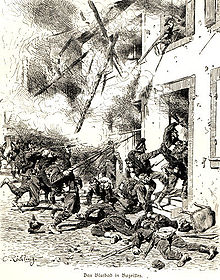Battle for Bazeilles



The battle for Bazeilles was an important battle of the Battle of Sedan in the Franco-German War of 1870-71, which began on Sept. 1, 1870 from 4 pm as part of the 1st Bavarian Division in the French village of Ardennes Bazeilles southeast Sedan marched .
procedure
The day before the Bavarian vanguard had prevented the railway bridge south of Bazeilles from being blown up, but encountered fierce resistance in the pursuit of the enemy in the village. In the evening she had withdrawn unmolested to the bridgehead north of the Meuse. The following night the French army had Bazeilles secured by infantry and marine infantry from the " Blue Division ", who had orders to defend the place to the last shot . Roads and massive houses were built for defense.
General Ludwig von der Tann-Rathsamhausen , commander of the I. Royal Bavarian Army Corps , ordered the attack on Bazeilles at around 4 a.m. on the morning of September 1st. Apparently out of personal ambition, he acted rashly, because Chief of Staff Helmuth von Moltke was still leading troops to the front at this point. During the attack in the poor light of the graying morning, the Bavarian units suffered heavy losses in the house-to-house fighting in a short time. The troops had to be reinforced in the course of the morning, so that by 9 o'clock the entire 1st Division and parts of the 2nd Division were in action in Bazeilles. On the French side too, reinforcements from the XII. Corps a. At 11 o'clock the French began to withdraw or surrender after eventful battles. These decisions were made when the town of Balan , located north between Bazeilles and Sedan, could no longer be held against Bavaria (formed mainly from residents of the Aisch Valley ) and Prussia attacking from the east .
Armed residents took part in the fighting in Bazeilles by shooting at the advancing soldiers and the wounded retreating from hiding places in the basement. Embittered by this, the Bavarians killed many of them and set fire to the houses from which the shots came. At noon the whole place was on fire.
losses
According to French information, the “Blue Division” alone lost 2,655 members on that day. The Bavarian Army lamented the loss of 4,089 dead and wounded at Sedan, including 213 officers, 106 of whom had died. Of these, the fighting for Bazeilles accounted for 64 fallen officers and around a thousand dead soldiers. The French propaganda initially mentioned a Bavarian massacre of men, women and children. According to an official French investigation, however, 39 residents of Bazeilles were killed and another 150 (10% of the population) died of injuries in the following months.
The battle for Bazeilles was particularly costly for the Bavarian Army and was considered by the German public as a bloody contribution to the Bavarian gun honor, an honorable cement for German unity . The battle for Bazeilles was a popular motif for important battle painters and illustrators of the late 19th century. Michael Zeno Diemer described the battle for Bazeilles in a panorama created in 1896 . It was shown in a specially constructed building in Mannheim. Even Anton von Werner mentioned him in 1883 in his Sedan panorama at Alexanderplatz in Berlin. The painters Otto von Faber du Faur , Friedrich Bodenmüller, Franz Adam , Carl Röchling , Richard Knötel and the French Alphonse de Neuville created today forgotten depictions of Bazeilles.
For the French marines, defending the last house on the road to Sedan down to the last cartridge is an act of identity that is honored to this day.
TV movies
- TV film by Hannes Schuler and Jan Lorenzen:
- DasErste.de : The great battles (SR) 4. 1870 - Sedan's decision ( Memento from September 29, 2009 in the Internet Archive )
- arte.tv: The great battles: 1870 - The decision of Sedan
- Book for the broadcasts: Jan N. Lorenzen: 1870 - Sedan without legend , in: The great battles. Myths, people, fates , Campus Verlag, Frankfurt 2006, ISBN 3-593-38122-2 . P. 155 ff.
Individual evidence
- ^ Max Döllner : History of the development of the city of Neustadt an der Aisch up to 1933. Ph. CW Schmidt, Neustadt ad Aisch 1950. (New edition 1978 on the occasion of the 150th anniversary of the Ph. CW Schmidt Neustadt an der Aisch publishing house 1828-1978. ) P. 643.
- ^ Schmidthuber (Ed.): The Franco-German War 1870/71 with special consideration of the participation of Bavaria. Extract from the General Staff Works, JF Rietsch, Landshut 1900, p. 90.
- ^ A b Site non officiel des Troupes De Marine
- ^ Schmidthuber (Ed.): The Franco-German War 1870/71 with special consideration of the participation of Bavaria. Extract from the General Staff Works, JF Rietsch, Landshut 1900, pp. 116/117.
- ↑ Jan N. Lorenzen: The great battles - myths, people, fates , Campus Verlag, 2006, Frankfurt a. M., p. 162. According to other information, 31 civilians were killed, wounded or missing in the immediate aftermath of the fighting. Dennis A. Showalter: The Face of Modern War. Sedan, September 1 and 2, 1870. In: Stig Förster, Markus Pöhlmann , Dierk Walter (eds.): Battles of world history. From Salamis to Sinai. Munich 2001, p. 239.
- ↑ Schmidthuber quotes General v. Helvig, in: The Franco-German War 1870/71 with special consideration of the participation of Bavaria. Excerpt from the General Staff Works, JF Rietsch, Landshut 1900, p. 116.
